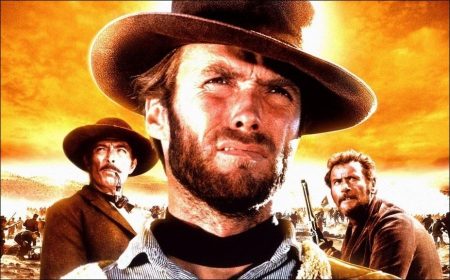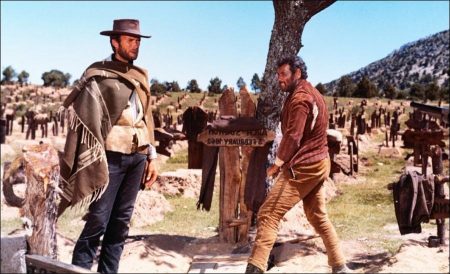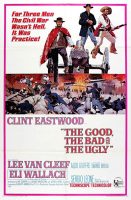The Good, The Bad, and The Ugly movie storyline. Set during the Civil War, three men search for a fortune in gold. One of these men is Angel Eyes, a cold blooded hired killer who was hired by a man to locate his partner who vanished with the gold but he doesn’t tell Angel Eyes why he wants him. But Angel Eyes finds out while looking for the man and tells the man who hired him what he found out. But he kills him so he can get the gold himself.
The other two men are Tuco and a guy he calls Blondie. Tuco is a bandit. Blondie captures him and turns him in for the reward. But when Tuco is about to be hung, Blondie saves him and they go off and do it somewhere else. After their latest attempt, Bloncie tells Tuco they’ve taken it as far as they can. He leaves Tuco and doesn’t give him his share. Tuco tracks him down and makes walk across the desert.
Later they come across a stagecoach filled with men who are dead wearing Confederate uniforms, Tuco finds a man dying who just happens to be the man Angel Eyes is looking for. He tells Tuco about the gold but before he could tell Tuco where it is he passes out. So Tuco goes to get some water but when he comes back, the man is dead. But Blondie is there and Tuco thinks the man told him where the gold is. So he nurses him back to health. They put on the uniforms and take the stagecoach.
They come across some soldiers who they thought were Confederate but were actually Union so they take them prisoner and bring them to the Fort. Angel Eyes is there, an officer. When he learns Tuco took the identity of the man is looking for, he assumes he knows about the gold. So he talks to Tuco and he “gets” him to tell him about the gold but Blondie is the one who knows where it is. So he brings Blondie to him but he’s not intimidated. So he agrees to take him to where the gold is. So the three of them head off to get the gold. But can they trust each other.
About the Film
The third and final installment (but actual a prequel) in under-rated Italian director Sergio Leone’s The Man with No Name epic trilogy, this is perhaps the best-known “spaghetti western” of all-time. ‘The Man with No Name’ was Eastwood’s star-making role, after appearances in the previous A Fistful of Dollars (1964) and For a Few Dollars More (1965).
Elements of his character can be found in his later anti-hero cop “Dirty” Harry Callahan character in Dirty Harry (1971). As with Leone’s other westerns, this film is viciously violent and machismo in tone, but buoyed by the classic, instantly-recognizable, twanging Ennio Morricone score.
In this sweeping, stylistic, and operatic film, The Man with No Name (but dubbed Blondie) (Eastwood) is the unsmiling anti-hero “Good” guy, Angel Eyes Sentenza (Lee Van Cleef) serves as the vile and ruthless “Bad” guy, and Tuco Ramirez (Eli Wallach) provides the greedy, talkative, clownish and self-centered “Ugly”. With very little dialogue, lots of closeups, and vast widescreen landscapes, the film’s plot, set during the Civil War, concerns the acquisition of a treasure chest of $200,000 in stolen Confederate gold buried in a grave at a faraway location.
All three of the main characters, basically amoral, anti-social bounty hunters, outlaws, and murderers, are forced to form an uneasy partnership or alliance, leading to the film’s climactic graveyard shootout in which the opportunistic desperados find themselves facing off one last time for the fortune. [In 2003, a special restored and extended English language version, almost three hours in length with about 15 minutes of previously-cut scenes, was released that used the original Italian release cut, with Clint Eastwood and Eli Wallach dubbing in their voices to scenes that were cut from the USA release.]
The Good, The Bad, and The Ugly (1966)
Directed by: Sergio Leone
Starring: Clint Eastwood, Eli Wallach, Lee Van Cleef, Aldo Giuffrè, Luigi Pistilli, Rada Rassimov, Claudio Scarchilli, Livio Lorenzon, Sandro Scarchilli, Antonio Casas, Benito Stefanelli, Angelo Novi
Screenplay by: Agenore Incrocci, Furio Scarpelli, Luciano Vincenzoni, Sergio Leone
Production Design by: Carlo Simi
Cinematography by: Tonino Delli Colli
Film Editing by: Eugenio Alabiso, Nino Baragli
Costume Design by: Carlo Simi
Makeup Department: Rino Carboni, Rino Todero
Music by: Ennio Morricone
Distributed by: United Artists
Release Date: December 23, 1966 (Italy), December 29, 1967 (United States)
Views: 769



